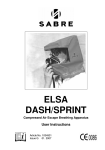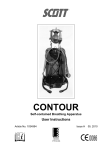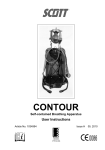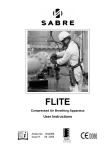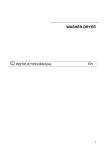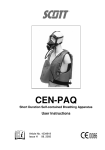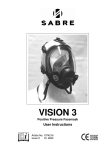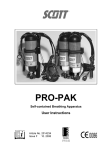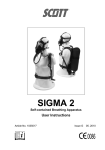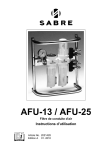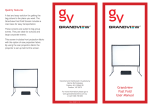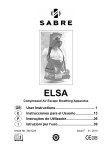Download Elsa Muster User Manual in English
Transcript
ELSA MUSTER Compressed Air Escape Breathing Apparatus User Instructions Article No. 2007280 Issue E 06. 2008 ELSA MUSTER Compressed Air Escape Breathing Apparatus Contents WARNINGS................................................................................................................................................. ii 1. INTRODUCTION............................................................................................................................... 1 1.1 BREATHABLE AIR ..............................................................................................................1 1.2 APPARATUS SELECTION ..................................................................................................1 1.3 TRAINING............................................................................................................................1 1.4 SERVICING .........................................................................................................................1 1.5 TRANSPORTATION............................................................................................................1 2. TECHNICAL DESCRIPTION ............................................................................................................ 2 2.1 GENERAL ...........................................................................................................................2 2.2 HOOD..................................................................................................................................2 2.3 FACEMASK .........................................................................................................................2 2.4 REDUCER / CYLINDER VALVE..........................................................................................2 2.5 COMPRESSED AIR AIRLINE SUPPLY...............................................................................2 2.6 AIRLINE PIGTAIL HOSE .....................................................................................................3 2.7 CYLINDERS ........................................................................................................................3 2.8 STORAGE BAG...................................................................................................................3 2.9 QUALITY ATTRIBUTES ......................................................................................................3 3. INSTRUCTIONS FOR USE............................................................................................................... 4 3.1 DON STORAGE BAG..........................................................................................................4 3.2 DON HOOD .........................................................................................................................4 3.3 DON FACEMASK ................................................................................................................5 3.4 CONNECT TO AIR SUPPLY OUTLET ................................................................................5 3.5 TO RESUME BREATHING FROM THE CYLINDER SUPPLY.............................................6 3.6 AFTER USE.........................................................................................................................6 3.6.1 Remove Hood ....................................................................................................6 3.6.2 Remove Facemask ............................................................................................6 3.6.3 All Versions........................................................................................................6 4. SCHEDULED MAINTENANCE......................................................................................................... 6 4.1 MAINTENANCE RESPONSIBILITIES .................................................................................6 4.2 ROUTINE CHECKS.............................................................................................................6 4.3 AFTER-USE CLEANING .....................................................................................................7 4.4 CHARGING CYLINDERS ....................................................................................................7 4.4.1 Remove Cylinder from Bag ................................................................................7 4.4.2 Charge Cylinder .................................................................................................7 4.4.3 Re-pack Apparatus in Bag .................................................................................8 4.5 WORKSHOP REPAIR AND ANNUAL SERVICING .............................................................8 Sabre Breathing Apparatus is a division of Scott Health and Safety Limited. Registered office: Scott Health and Safety Limited, Pimbo Road, West Pimbo, Skelmersdale, Lancashire, WN8 9RA, England. i WARNINGS Please Read Carefully and Fully Understand This manual is for use by personnel trained in the use and care of compressed air escape apparatus, and MUST NOT be used as a self-teaching guide by untrained users. Scott Health and Safety Limited have taken great care to ensure that the information in this manual is accurate, complete and clear. However, Training and Technical Support Services will be pleased to clarify any points in the manual and answer questions on Sabre breathing apparatus. If you need to use this apparatus you will be in an unusual, possibly life-threatening situation. Poor visibility and toxic fumes may add to your difficulties. Prepare for that situation: • • • • • Learn the location of escape apparatus and how to gain access to it. Learn to use the escape apparatus, as detailed in these instructions. Be aware of the protection limits provided by ELSA Muster. Exceeding these limits may cost you your life, or result in injury. Be fully aware of workplace hazards. Become familiar with planned escape routes. If the situation arises: • • • Remain calm and remember what you must do to survive. Don and activate the apparatus. Leave the hazard area immediately. Do not enter a hazard area unless it is part of the escape route. General and Managerial: • • • • • Check apparatus daily when issued to wearers or deployed in ready-use lockers, or monthly if held in stores. Additional risks may be encountered if this apparatus is used in an explosive atmosphere. ELSA Muster is an escape apparatus. DO NOT use for other purposes, such as fire-fighting or cargo handling. Ensure wearers are fully trained in the use of the apparatus, advised of workplace hazards and planned escape routes. Ensure ELSA Muster provides respiratory protection for workplace hazards and has duration for planned escape routes. Refer to EN 529 : 2005 - Guide to implementing an effective respiratory protective device programme. DISCLAIMER Failure to comply with these instructions or misuse of the apparatus may result in: death, injury or material damage, and invalidate any warranty or insurance claims. COPYRIGHT This manual must not be copied in part or whole, or used for purposes other than its intended purpose without the written permission of Scott Health and Safety Limited. ii ELSA MUSTER 1. INTRODUCTION 1.3 1.1 These instructions cannot replace an accredited training course run by fully qualified instructors in the proper and safe use of Sabre breathing apparatus. Please contact Training and Technical Support Services or your Sabre distributor for training course details. BREATHABLE AIR Air for compressed air breathing apparatus may be natural or synthetic. A typical composition of natural air is shown in Table 1. Component Mass % (dry air) Vol. % (dry air) Oxygen Nitrogen Argon Carbon Dioxide Hydrogen Neon Helium Krypton Xenon 23.14 75.52 1.288 0.048 0.000 003 0.001 27 0.000 330 0.000 0732 0.000 039 20.947 6 78.084 0.934 0.031 4 0.000 05 0.001 818 0.000 524 0.000 114 0.000 009 Training and Technical Support Services: Scott Health and Safety Limited Pimbo Road, West Pimbo, Skelmersdale, Lancashire, WN8 9RA, England. Tel: +44 (0) 1695 711711 Fax: +44 (0) 1695 711775 1.4 SERVICING ELSA Muster must be serviced by personnel who have completed a formal training course and hold a current certificate for servicing and repairing Sabre breathing apparatus. Details of the Servicing Schedule are contained in the ELSA Muster Service Manual, copies of which can only be obtained by registered holders of a current certificate. Table 1: Breathable Air The quality of air used to supply and charge breathing apparatus must conform to European Standard EN 12021 : 1999 (Requirements for Breathable Air). Fire risk increases when the oxygen level rises above the value shown in Table 1. Your Sabre distributor or Training and Technical Support Services will be pleased to provide training course details and quotes for service contracts. Please see above for contact details. Contaminants must be kept to a minimum, and must not exceed permissible exposure levels. Cylinder water content of air at atmospheric pressure must not exceed 3 50 mg/m for 200 bar cylinders or 35 3 mg/m for 300 bar cylinders. 1.5 TRANSPORTATION It is essential that ELSA Muster is transported in suitable packaging. Refer to the Health and Safety document: Guide to the Pressure Systems and Transportable Gas Container Regulations 1989. National regulations for compressed air breathing apparatus must be observed. 1.2 TRAINING APPARATUS SELECTION When selecting respiratory protective equipment the following factors must be considered: • Hazards likely to be encountered and their effect on the wearer. • Physical and emotional stress and their effect on wearer breathing rate. • The type of respiratory protection required. Where an ELSA Muster with a charged cylinder is to be transported by road, the Road Traffic Regulations 1986, although primarily intended to cover toxic, flammable and corrosive gases, should be observed. After transportation, ELSA Muster should be checked to ensure that: • The bag and contents gauge have not been damaged. • The anti-tamper tags are intact. 1 ELSA MUSTER ELSA Muster should be stored, away from direct heat and sunlight and operated at between -15°C and +60°C. Prior to storing in very low temperatures the apparatus, especially the valve flaps, must be completely dry. 2. TECHNICAL DESCRIPTION 2.1 GENERAL ELSA Muster is a self contained, open circuit, compressed air, positive-pressure, escape, breathing apparatus with an airline attachment. The airline attachment allows the wearer to connect to an external supply of breathable air at a Muster Point. ELSA Muster consists of a compressed air cylinder with a combined reducer/cylinder valve (RCV) and a hood or facemask, all of which are contained within an anti-static bag. 2.2 HOOD The hood is fabricated in high-visibility, flame-retardant PVC or PVC-coated materials with a rubber neck-seal. An inner mask, that covers the wearer’s nose and mouth, minimises visor misting and carbon dioxide ‘dead space’. The springloaded exhale valve helps maintain an above ambient pressure within the hood. ELSA Muster has a 3 litre (15 minute), 200 bar, steel cylinder. Owing to its weight, ELSA Muster is not suitable for wearing for complete 8 hour shifts. 2.3 FACEMASK The PanaSeal facemask is made from non-dermatitic, black neoprene material and features a fully-adjustable polyester net head-harness. The mask is approved to EN 136 for use with positive-pressure breathing apparatus. The PanaSeal mask incorporates a speech diaphragm to aid communication and an inner mask which reduces carbon dioxide ‘dead space’ and prevents visor misting. The cylinder air supply is activated when the access flap is opened. A cord, attached to the flap and wound around the RCV hand-wheel, turns the handwheel and opens the valve, thus releasing a flow of air at between 5.5 and 9 bar to the facepiece-mounted, positivepressure demand valve. In the unlikely event that the cord fails to open the RCV when the bag is opened, the hand-wheel is readily accessible to the wearer and can be operated manually. 2.4 REDUCER / CYLINDER VALVE The RCV is a spring and piston device that outputs air at between 5.5 and 9 bar. A charging adaptor, that conforms to EN 144-2 : 1996, is provided. A burst disc is fitted, thus preventing the system from being overcharged. The demand valve is activated when the wearer takes a sharp breath, thereafter air will flow into the hood or facemask. Pictogram user instructions and the duration of the air supply are prominently visible on the bag. Two bright red antitamper tags seal the bag. The tags break easily when the bag is opened, or if the apparatus is tampered with. 2.5 COMPRESSED AIR AIRLINE SUPPLY Air for use with compressed air airlines should have a dew-point sufficiently low to prevent internal freezing. While ELSA Muster is stored ready for use, the cylinder contents gauge is visible though a transparent panel in the bag, permitting the cylinder charge state to be checked without opening the bag. The airline pressure should be between 5 and 9 bar, (the maximum working pressure of the hose is 15 bar). The air-flow should be at 300 litres per minute with a maximum airline supply length of 3 metres. Providing the apparatus is serviced regularly in accordance with the service requirements detailed in the ELSA Muster Service Manual, there are no shelf life limits. 2 ELSA MUSTER 2.6 AIRLINE PIGTAIL HOSE 2.9 Connection of the apparatus to a Muster Station is by means of a pigtail hose fitted with a CEN coupling. The pigtail hose has a working pressure of between 6 and 11 bar; and burst pressure in excess of 80 bar. 2.7 ELSA Muster is accordance with EC/686/1986. CYLINDERS 10 Minutes Duration QUALITY ATTRIBUTES ELSA Muster is approved to a Scott Health and Safety Limited technical specification with hood and EN 402 for full facemask (Respiratory Protective Devices for Escape). 15 Minutes Duration 'CE' marked in EEC Directive Sabre Breathing Apparatus is an ISO9001 : 2000 approved Division of Scott Health and Safety Limited. Water Capacity 2 Litres 3 Litres Charging Pressure 200 bar 200 bar Working Pressure 200 - 10 bar 200 - 10 bar Duration 10 minutes (nominal). 15 minutes (nominal). Free Air Capacity 400 Litres 560 Litres NOTIFIED BODY: British Standards Institute (No. 0086) Kitemark House, Maylands Avenue, Hemel Hempstead, HP2 4SQ England. Charged Weight of Complete Apparatus 4.1kg 5.3kg Exception: The ELSA Muster airline attachment is not EN-approved. 2.8 STORAGE BAG The bag is fabricated from lightweight, black, anti-static material and has a webbing strap which supports the bag during use. The access flap is held closed by pressstuds and is opened by pulling a webbing grab strap. The quick fire cord connects the access flap to the reducer/cylinder valve. A transparent panel is provided to enable the cylinder contents gauge to be checked without opening the bag. 3 ELSA MUSTER 3. INSTRUCTIONS FOR USE 3.1 DON STORAGE BAG When issued to a wearer and prior to each use, the wearer must check that: • The anti-tamper tag is in place. • The contents gauge shows that the cylinder is full. 1. Lift ELSA Muster from the readyto-use store and place the neckstrap around the neck so that the pictogram on the bag is outermost. 2. Place the palms of the hands together and insert through the rubber neck-seal. Open the hands to open the hood. CAUTION: • Ensure that finger nails and rings do not snag or tear the neckseal. • Do not roll or fold the neck-seal when donning the hood. 2. Hold the bag and pull the flap to open the reducer/cylinder valve. 3. Listen for the sound of air charging the system, which will confirm that the cylinder valve is open. If necessary grasp the cylinder valve hand-wheel and turn fully anti-clockwise. 3.2 DON HOOD 3. Hold the hood with the neck-seal over the crown of the head and pull the hood down over the head until the neckseal is around the neck. 4. Ensure that your clothing or hair do not become trapped in the neck-seal. 1. Pull the hood from the bag. 4 ELSA MUSTER 2. Tighten the harness side straps. DO NOT over-tighten 3. Inhale sharply to actuate the first breath mechanism and go immediately to your Muster Station. 3.4 CONNECT TO AIR SUPPLY OUTLET 5. Inhale sharply to activate the first breath mechanism and go immediately to your Muster Station. 3.3 DON FACEMASK 1. Remove the dustcap from the airline coupling and connect the coupling to a Muster Station air supply outlet. 2. Turn the cylinder valve hand-wheel fully clockwise to shut off the cylinder supply. WARNING: If the cylinder valve is not closed while breathing from the Muster Station supply, the cylinder will empty. 1. Hold the mask by the side of net harness, place the chin into the chin-cup and pull the mask onto the face. Grasp the pull-strap at the rear of the net harness and pull the net over the head. 5 ELSA MUSTER 3.5 TO RESUME BREATHING FROM THE CYLINDER SUPPLY 4. SCHEDULED MAINTENANCE 4.1 1. Turn the RCV hand-wheel fully anticlockwise. Wearer maintenance options: • No wearer maintenance. • Wearer performs daily (or monthly) checks. • Wearer performs daily (or monthly) checks, cleans and, when the apparatus has been used, prepares the apparatus for future use. 2. Push the airline coupling together, pull back the locking collar and pull the coupling apart. 3.6 3.6.1 AFTER USE Remove Hood 1. When clear of the hazard area, insert thumbs under the neck-seal and remove the hood. 3.6.2 MAINTENANCE RESPONSIBILITIES Your Safety Officer will advise which of the above applies. Remove Facemask Maintenance tasks not performed by wearers must be referred to a properly equipped and trained service facility. DO NOT perform maintenance tasks unless you have been trained and tasked to do so by a qualified, responsible expert. 4.2 ROUTINE CHECKS It is a mandatory requirement that all escape apparatus shall be checked at monthly intervals. In addition, apparatus issued to wearers should be checked when issued and daily thereafter. Apparatus held in ready-use lockers should be checked daily. 1. Take a deep breath and depress the black reset button on the demand valve. Apparatus held ready for use in a central store must be checked monthly, as follows: • Check that the contents gauge needle is in the green sector, showing that the cylinder is fully charged. • Check that the bag is clean and undamaged; and that the antitamper tags are in place and unbroken. • Check that access to the bag is unobstructed. • Check that the quick-fire cord is attached to the bag flap and wound around the RCV hand-wheel. 2. Release the net harness by pushing the buckles away from you whilst pulling the straps through the buckles. 3.6.3 All Versions Once the apparatus has been used it must be returned for servicing and recharging. 6 ELSA MUSTER • 4.4 Check the airline supply pressure and flow at the Muster Station to ensure that it conforms to the details given in Section 2.5 of this manual under Compressed Air Airline Supply. Apparatus that fails any of these checks must be returned for workshop service or repair. 4.3 CHARGING CYLINDERS WARNING: • HP compressors and charging apparatus must only be used by trained operators. • Wear eye protection when working with HP air. • Air used to charge cylinders must conform to EN 12021 : 1999. AFTER-USE CLEANING CAUTION: DO NOT immerse the hood or reducer/cylinder valve. Fluid MUST NOT enter the inner mask. 4.4.1 Remove Cylinder from Bag 1. Break the anti-tamper tags, open the bag carefully and release the quickfire cord from the bag flap. 1. Wipe the surface of the hood and bag using a clean, lint-free cloth moistened in a solution of TriGeneTM and warm water. See following Note. 2. Ease the contents gauge through the slot in the bag window and withdraw the cylinder from the bag. 2. Allow the hood and bag to dry naturally, away from direct heat and sunlight. 3. Flex the hoses and check for wear and damage. Return the apparatus for service if the hoses are worn or damaged. 3. Disinfect the neck-seal using a TriGeneTM disinfectant wipe. 4.4.2 Note: TriGeneTM is available from Scott Health and Safety Limited in 1 litre and 5 litre containers under Article Numbers 2008247 and 2008248 respectively. Charge Cylinder 1. Remove the charging adaptor blanking plug and store safely for use later. Check that the RCV hand-wheel is turned fully clockwise. 2. Fit 200 bar G5/8 pattern charging connector to the charging adaptor. Pump dispensers are available for the above under Article Numbers 1017672 (1 litre) and 1017670 (5 litres). CAUTION: DO NOT immerse the cylinder valve. TriGene disinfecting wipes are available from Scott Health and Safety Limited under Article Number 2004225 (Pack of 20). TM 3. Immerse the cylinder vertically in water so that 3/4 of the cylinder is covered. 4. Use an ExxeneTM de-misting wipe, available under Article Number 2011081 (Pack of 10) from Scott Health and Safety Limited, to polish the visor. 4. Slowly open the compressor supply valve. Charge cylinders at 40 L/min (10 minute duration cylinders should take approximately 10 minutes to charge and 15 minute duration cylinders approximately 15 minutes), then close the compressor supply valve. 5. When the cylinder has cooled, check that it is full. If necessary, open the supply valve briefly until the contents gauge shows full. 7 ELSA MUSTER 5. Locate the cord toggle in a notch on the RCV hand-wheel, wind the cord firmly around the hand-wheel in an anticlockwise direction and attach the end to the bag flap. 6. Close the bag flap and fit antitamper tags. 4.5 6. Turn off the charging supply valve, bleed off pressure from the supply hose, disconnect the charging adaptor from the cylinder and fit the charging adaptor blanking plug. The apparatus must be returned for workshop servicing if: • The anti-tamper tag is broken. • The contents gauge shows less than full. • The apparatus has been used. • A scheduled, annual service is due (please refer to the ELSA Muster Service Manual). 7. Remove the cylinder from water, dry thoroughly and insert it into the bag. 4.4.3 WORKSHOP REPAIR AND ANNUAL SERVICING Re-pack Apparatus in Bag 1. Slide the cylinder into the bag and ensure that the cylinder fits through the retaining strap inside the bag. Apparatus stored in a corrosive, dusty, or humid environment may require more frequent servicing. Please contact Training and Technical Support Services if you have any service or operating enquiries. 2. Fit the contents gauge through the slot in the bag so that the gauge can be seen clearly when the bag is closed. 3. Feed approximately half of the breathing hose into the bag. 4. Fold the hood and insert carefully into the bag. Arrange the breathing hose under the rear of the hood so that it will not foul when the hood is pulled from the bag. 8 Sabre Breathing Apparatus Scott Health and Safety Limited Pimbo Road, West Pimbo, Skelmersdale, Lancashire, WN8 9RA, England. Tel: +44 (0) 1695 711711 Fax: +44 (0) 1695 711775












